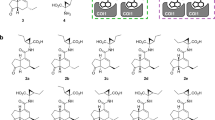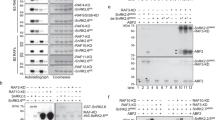Abstract
The phytohormone abscisic acid (ABA) functions through a family of fourteen PYR/PYL receptors, which were identified by resistance to pyrabactin, a synthetic inhibitor of seed germination. ABA activates these receptors to inhibit type 2C protein phosphatases, such as ABI1, yet it remains unclear whether these receptors can be antagonized. Here we demonstrate that pyrabactin is an agonist of PYR1 and PYL1 but is unexpectedly an antagonist of PYL2. Crystal structures of the PYL2–pyrabactin and PYL1–pyrabactin–ABI1 complexes reveal the mechanism responsible for receptor-selective activation and inhibition, which enables us to design mutations that convert PYL1 to a pyrabactin-inhibited receptor and PYL2 to a pyrabactin-activated receptor and to identify new pyrabactin-based ABA receptor agonists. Together, our results establish a new concept of ABA receptor antagonism, illustrate its underlying mechanisms and provide a rational framework for discovering novel ABA receptor ligands.
This is a preview of subscription content, access via your institution
Access options
Subscribe to this journal
Receive 12 print issues and online access
$189.00 per year
only $15.75 per issue
Buy this article
- Purchase on Springer Link
- Instant access to full article PDF
Prices may be subject to local taxes which are calculated during checkout






Similar content being viewed by others
References
Park, S.Y. et al. Abscisic acid inhibits type 2C protein phosphatases via the PYR/PYL family of START proteins. Science 324, 1068–1071 (2009).
Ma, Y. et al. Regulators of PP2C phosphatase activity function as abscisic acid sensors. Science 324, 1064–1068 (2009).
Santiago, J. et al. Modulation of drought resistance by the abscisic acid receptor PYL5 through inhibition of clade A PP2Cs. Plant J. 50, 575–588 (2009).
Belin, C. et al. Identification of features regulating OST1 kinase activity and OST1 function in guard cells. Plant Physiol. 141, 1316–1327 (2006).
Fujii, H., Verslues, P.E. & Zhu, J.K. Identification of two protein kinases required for abscisic acid regulation of seed germination, root growth, and gene expression in Arabidopsis . Plant Cell 19, 485–494 (2007).
Umezawa, T. et al. Type 2C protein phosphatases directly regulate abscisic acid-activated protein kinases in Arabidopsis . Proc. Natl. Acad. Sci. USA 106, 17588–17593 (2009).
Yoshida, R. et al. The regulatory domain of SRK2E/OST1/SnRK2.6 interacts with ABI1 and integrates abscisic acid (ABA) and osmotic stress signals controlling stomatal closure in Arabidopsis . J. Biol. Chem. 281, 5310–5318 (2006).
Furihata, T. et al. Abscisic acid-dependent multisite phosphorylation regulates the activity of a transcription activator AREB1. Proc. Natl. Acad. Sci. USA 103, 1988–1993 (2006).
Kobayashi, Y. et al. Abscisic acid-activated SNRK2 protein kinases function in the gene-regulation pathway of ABA signal transduction by phosphorylating ABA response element-binding factors. Plant J. 44, 939–949 (2005).
Nishimura, N. et al. ABA-hypersensitive germination1 encodes a protein phosphatase 2C, an essential component of abscisic acid signaling in Arabidopsis seed. Plant J. 50, 935–949 (2007).
Viswanathan, C. & Zhu, J.K. Molecular genetic analysis of cold-regulated gene transcription. Phil. Trans. R. Soc. Lond. B 357, 877–886 (2002).
Xiong, L., Schumaker, K.S. & Zhu, J.K. Cell signaling during cold, drought, and salt stress. Plant Cell 14 Suppl, S165–S183 (2002).
Yamaguchi-Shinozaki, K. & Shinozaki, K. Transcriptional regulatory networks in cellular responses and tolerance to dehydration and cold stresses. Annu. Rev. Plant Biol. 57, 781–803 (2006).
Yoshida, T. et al. ABA-hypersensitive germination3 encodes a protein phosphatase 2C (AtPP2CA) that strongly regulates abscisic acid signaling during germination among Arabidopsis protein phosphatase 2Cs. Plant Physiol. 140, 115–126 (2006).
Zhu, J.K. Salt and drought stress signal transduction in plants. Annu. Rev. Plant Biol. 53, 247–273 (2002).
Melcher, K. et al. A gate-latch-lock mechanism for hormone signalling by abscisic acid receptors. Nature 462, 602–608 (2009).
Miyazono, K. et al. Structural basis of abscisic acid signalling. Nature 462, 609–614 (2009).
Nishimura, N. et al. Structural mechanism of abscisic acid binding and signaling by dimeric PYR1. Science 326, 1373–1379 (2009).
Santiago, J. et al. The abscisic acid receptor PYR1 in complex with abscisic acid. Nature 462, 665–668 (2009).
Yin, P. et al. Structural insights into the mechanism of abscisic acid signaling by PYL proteins. Nat. Struct. Mol. Biol. 16, 1230–1236 (2009).
McCourt, P. & Creelman, R. The ABA receptors—we report you decide. Curr. Opin. Plant Biol. 11, 474–478 (2008).
Harris, M.J., Outlaw, W.H., Mertens, R. & Weiler, E.W. Water-stress-induced changes in the abscisic acid content of guard cells and other cells of Vicia faba L. leaves as determined by enzyme-amplified immunoassay. Proc. Natl. Acad. Sci. USA 85, 2584–2588 (1988).
Zhang, S.Q., Outlaw, W.H. Jr. & Aghoram, K. Relationship between changes in the guard cell abscisic-acid content and other stress-related physiological parameters in intact plants. J. Exp. Bot. 52, 301–308 (2001).
Christmann, A., Hoffmann, T., Teplova, I., Grill, E. & Muller, A. Generation of active pools of abscisic acid revealed by in vivo imaging of water-stressed Arabidopsis . Plant Physiol. 137, 209–219 (2005).
Zhao, Y. et al. Chemical genetic interrogation of natural variation uncovers a molecule that is glycoactivated. Nat. Chem. Biol. 3, 716–721 (2007).
Fujii, H. et al. In vitro reconstitution of an abscisic acid signalling pathway. Nature 462, 660–664 (2009).
Mertens, R., Deus-Neumann, B. & Weiler, E.W. Monoclonal antibodies for the detection and quantitation of the endogenous plant growth regulator, abscisic acid. FEBS Lett. 160, 269–272 (1983).
Huang, D., Wu, W., Abrams, S.R. & Cutler, A.J. The relationship of drought-related gene expression in Arabidopsis thaliana to hormonal and environmental factors. J. Exp. Bot. 59, 2991–3007 (2008).
Radauer, C., Lackner, P. & Breiteneder, H. The Bet v 1 fold: an ancient, versatile scaffold for binding of large, hydrophobic ligands. BMC Evol. Biol. 8, 286 (2008).
Otwinowski, Z., Borek, D., Majewski, W. & Minor, W. Multiparametric scaling of diffraction intensities. Acta Crystallogr. A 59, 228–234 (2003).
McCoy, A.J. et al. Phaser crystallographic software. J. Appl. Crystallogr. 40, 658–674 (2007).
Kleywegt, G.J. & Jones, T.A. Efficient rebuilding of protein structures. Acta Crystallogr. D Biol. Crystallogr. 52, 829–832 (1996).
Emsley, P. & Cowtan, K. Coot: model-building tools for molecular graphics. Acta Crystallogr. D Biol. Crystallogr. 60, 2126–2132 (2004).
Brunger, A.T. et al. Crystallography & NMR system: A new software suite for macromolecular structure determination. Acta Crystallogr. D Biol. Crystallogr. 54, 905–921 (1998).
Murshudov, G.N., Vagin, A.A., Lebedev, A., Wilson, K.S. & Dodson, E.J. Efficient anisotropic refinement of macromolecular structures using FFT. Acta Crystallogr. D Biol. Crystallogr. 55, 247–255 (1999).
Acknowledgements
We thank the staff of Life Sciences Collaborative Access Team for assistance in data collection at the beam lines of sector 21, which is in part funded by the Michigan Economic Development Corporation and the Michigan Technology Tri-Corridor. Use of the Advanced Photon Source was supported by the Office of Science of the US Department of Energy. This work was supported by the Jay and Betty Van Andel Foundation (H.E.X.) and the US National Institutes of Health (H.E.X. and J-K.Z.). L.-M.N. and F.-F.S. were supported by an overseas PhD scholarship from the National University of Singapore Graduate School for Integrative Sciences & Engineering.
Author information
Authors and Affiliations
Contributions
K.M., J.L., E.-L.Y., S.R.C., J.-K.Z. and H.E.X. conceived the project and designed research; K.M., Y.X., L.-M.N., X.E.Z., F.-F.S., V.C., K.M.S.-P., A.K., F.S.T. and H.E.X. performed research; K.M., Y.X., L.-M.N., X.E.Z., F.-F.S., V.C., K.M.S.-P., A.K., F.S.T., S.R.C., J.-K.Z. and H.E.X. analyzed data; K.M. and H.E.X. wrote the paper with contributions from all authors.
Corresponding authors
Ethics declarations
Competing interests
The authors declare no competing financial interests.
Supplementary information
Supplementary Text and Figures
Supplementary Figures 1–9 (PDF 1652 kb)
Rights and permissions
About this article
Cite this article
Melcher, K., Xu, Y., Ng, LM. et al. Identification and mechanism of ABA receptor antagonism. Nat Struct Mol Biol 17, 1102–1108 (2010). https://doi.org/10.1038/nsmb.1887
Received:
Accepted:
Published:
Issue Date:
DOI: https://doi.org/10.1038/nsmb.1887
This article is cited by
-
Genome-wide identification and characterization of ABA receptor PYL/RCAR gene family reveals evolution and roles in drought stress in Nicotiana tabacum
BMC Genomics (2019)
-
Contrasting patterns of hormonal and photoprotective isoprenoids in response to stress in Cistus albidus during a Mediterranean winter
Planta (2019)
-
Comprehensive survey of the VxGΦL motif of PP2Cs from Oryza sativa reveals the critical role of the fourth position in regulation of ABA responsiveness
Plant Molecular Biology (2019)
-
Structural determinants for pyrabactin recognition in ABA receptors in Oryza sativa
Plant Molecular Biology (2019)
-
Identification of new abscisic acid receptor agonists using a wheat cell-free based drug screening system
Scientific Reports (2018)



